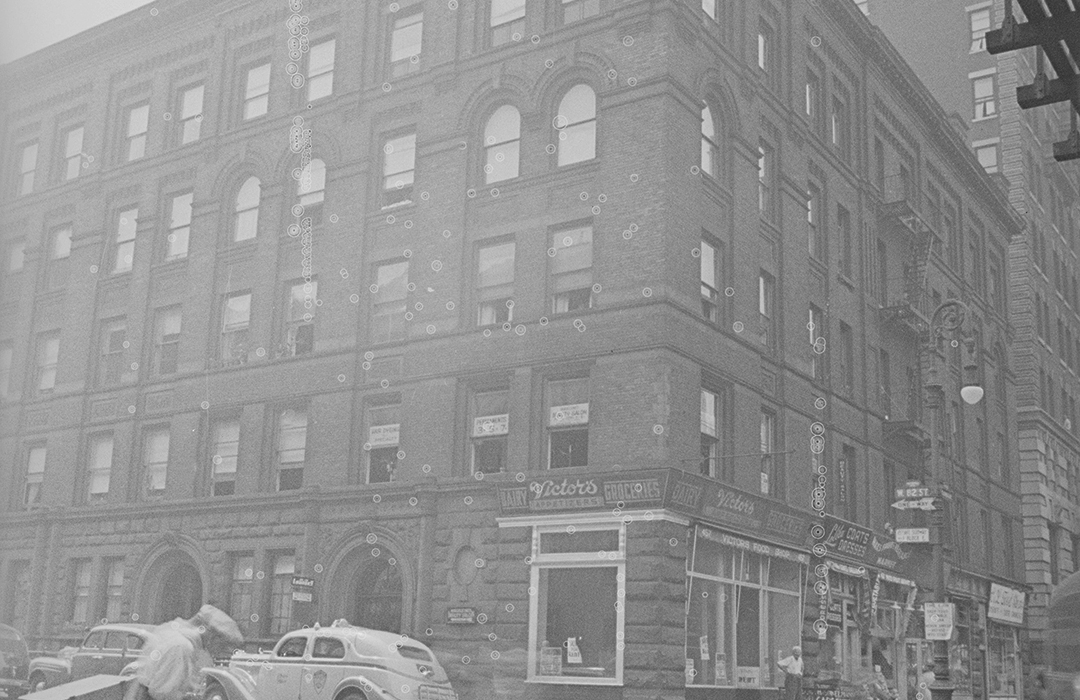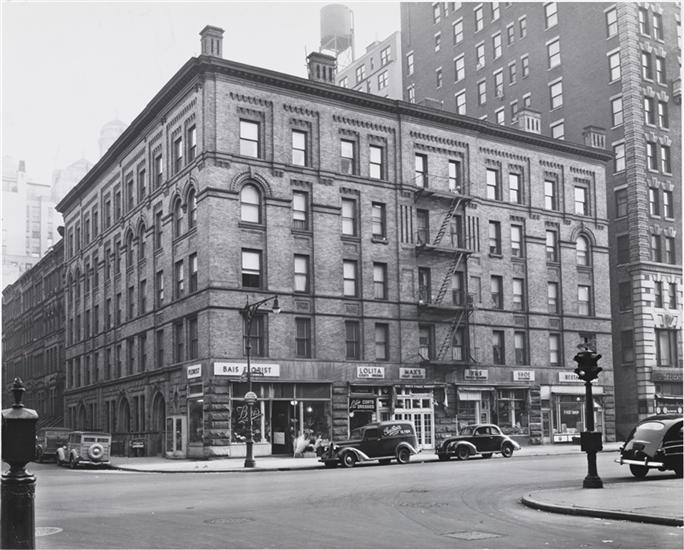
Smoking Hot at The Nebraska
by Tom Miller, for They Were Here, Landmark West’s Cultural Immigrant Initiative
On December 20, 1890 The Record & Guide opined “There are comparatively few builders engaged in more extensive improvements on the West Side than Chas. McDonald.” Indeed, that year alone McDonald had furiously begun construction of numerous houses and apartment buildings on the Upper West Side. Among the projects were the three five-story “flats” and seven four-story houses stretching east from the corner of 82nd Street and Columbus Avenue.
The corner building would be different from the other two apartment buildings in that the architectural firm of Thom & Wilson had included four stores along the Columbus Avenue side. Called the Nebraska it was faced in orange brick and trimmed in brownstone. Although it was predominantly Renaissance Revival in style, the architects gave the residential entrance at 80 West 82nd Street a decided Romanesque flavor.
Among the initial commercial tenants were the William R. Ware real estate office in 451 Columbus, the American District Telegraph Company Messenger Service branch at 453, and a branch of the Colonial Bank in 457.
In the meantime, the apartments filled with upscale residents like Webster Elmes and his wife. An attorney, Elmes had been associate counsel in the Law Division of the U. S. Custom House for two decades, having been previously the Solicitor of the Treasury Department. He would write Elmes’s Laws of the Customs while living here. His wife, the former Rose White, was prominent in West Side society. The Memorial Cyclopedia of the Twentieth Century would later say that Rose “is a descendant of old Southern families” and that “John White was one of Lord Baltimore’s councilors.”
The Upper West Side neighborhood was plagued by an arsonist in the spring of 1895, and on May 29 The Evening World reported “Another one of those mysterious upper west side fires, supposed to be the work of firebugs, broke out shortly after 10 o’clock last night in the basement of the eight-story [sic] brick apartment-house, the Nebraska.” As had been the case with the others, the fire had started in the basement. Although it was contained there, thick smoke filled the upper floors. Families and their live-in servants scrambled to escape.
Two of the maids worked on the second floor. “One colored woman climbed down the escape from the second floor,” reported The Evening World. The other, Jennie Low, was a servant of H. S. Schultz. The newspaper reported that she “became so excited that she threw her gold watch, ring and trinkets out of the window, and snatching up a pet dog and a pet monkey belonging to Mr. Schultz, ran to the roof with them. She forgot the seventeen canary birds and a parrot which Mr. Schultz kept in his apartment, and they were all suffocated by the smoke.”
The newspaper reported that she “became so excited that she threw her gold watch, ring and trinkets out of the window, and snatching up a pet dog and a pet monkey belonging to Mr. Schultz, ran to the roof with them.
So frantic was the nurse who worked for the family of John B. Bocock that she reached the street before realizing “that she had left Mr. Bocock’s two children, five and seven years old, locked in the apartment.” The janitor, James Haines rushed back in and “battered in the door with a settee and rescued the children. Both were nearly asphyxiated by the smoke, but soon recovered.”
Other than Schultz’s dead birds, there were no injuries and the damage was limited to about $1,570 in today’s money.
On June 10, 1896 Rose Elme hosted the Daughters of the American Revolution along with “four favored Sons of the American Revolution.” Elon S. Hobbs was guest of honor “in that it was at the house of his mother’s grandfather that the members of the famous Boston Tea Party donned their disguise,” explained The New York Press. The newspaper called Rose’s reception “a novel entertainment” because she broke traditional rules. Events that began in the late afternoon were called “Five O’Clocks” and guests were, by custom, served either tea or coffee. The New York Press said, “It might, however, be termed a ‘five o’clock punch,’ for there was a generous supply of deliciously cold champagne punch served with a tempting meal of cold birds, etc., that, at another hour, would have come under the head of a luncheon. It was essentially a man’s feast, and, therefore, the more enjoyed by the women.”
Born in England, Dr. Arthur Beaumont had come to American in 1837 at the age of 11. First practicing dentistry in Georgia, he moved his family to New York in 1895 and took an apartment in the Nebraska. The New York Times said of him, “He stood high in his profession, built up a large practice.” He and his wife had four children–three girls, and a boy who was born the year after they moved in.
Trouble began in June 1898 when Beaumont was diagnosed with malaria. The New York Times wrote, “malaria drove him to drink. He also smoked cigarettes incessantly. These seemed his only faults. He was a good husband and father.”
The newspaper continued, “But the drink habit meant professional decadence. Some of his patients fell away; others at times he had to turn away.” Soon Beaumont was behind in his bills and by December he was four months behind on the rent. Fearful of being evicted he told his wife, “If I have to go out of this flat, I’ll go out in a coffin.” A few days later the presentiment came to pass.
At 8:30 on the morning of December 5, 1898 Mrs. Beaumont was in the dining room preparing the older girls for school when she heard a pistol shot. She rushed to a buzzer that rang the janitor. The New York Times said that he found the dentist “lying on his back with a gaping bullet wound right over the heart.” The Morning Telegram added, “He died almost instantly.”
There were domestic problems in the household of bookkeeper Arthur K. Richardson and his wife at the time. Richardson was described by The Morning Telegram as “frail and timid” and by one of his employers at Packhardt & Stockbridge, as “a quiet, peaceful and affectionate young man.” His wife, on the other hand was domineering and abusive. The Morning Telegram held Mrs. Richardson as an example of “the new woman” who holds “absolutely sway.” In court Richardson described her as “a woman of large stature and physically strong and robust, weighing about 200 pounds. She is at times of a violent and unreasonable temper and is also addicted to drink.” He summed it up in a single sentence. “She is an Amazon.”
The breaking point came on the evening of July 17, 1898. The Morning Telegram recounted his testimony, saying when he came home from work “almost immediately she attacked him, using his face for a punching bag, his breast for a body exerciser and his entire frame for a doormat.” He tried to hold her arms down, but she escaped. “Then she swore—now, this is according to his story—if he attempted to restrain her again she would throw vitriol in his face.”
The noises of her continued battering of her husband drew a neighbor to Richardson’s rescue. The newspaper said “a lady who lives in the building came to his aid. They both held his violent wife.” When the opportunity arose, Richardson darted from the apartment with his wife in close pursuit. He was rescued again by the neighbor lady who “interfered” with his wife’s catching up with him. Arthur Richardson was too afraid to ever return to his apartment in the Nebraska.
At the turn of the century William R. Ware still ran his real estate office from 451 Columbus Avenue, and would remain at least through 1912. The former bank space at 457 was now a florist shop.
Among the upstairs residents was the Kaltenborn family. Carl Kaltenborn was a native of Mecklenburg, Germany and had arrived in the United States in the early 1870’s. He was a well-known cello player, especially among the German musical community. He and his wife had two children, a son and a daughter. Franz Kaltenborn was also a musician and the head of the Kaltenborn String Quartet. He shared the apartment with his parents.
Carl Kaltenborn died in his apartment in the summer of 1903 at the age of 73. German musical groups paid honor at his funeral on August 20. The Musical Courier noted that among them were “the Aschenbroedel Verein, the Musical Mutual Protective Union and the Roenberg Club,” adding that a “quarter of French horn players led by Hermann Dutschke added impressive music to the Lutheran ritual…When the procession passed the Aschenbroedel Verein a brass band conducted by Mr. Frank played Chopin’s Funeral March.”
One of the original tenants, Webster Elmes died in his apartment on May 9, 1905. He was still working in the Custom House after thirty years.
John Weideman and his wife Lena lived here at the time. John operated a newsstand at the corner of 81st Street and Columbus Avenue, and Lena ran a manicuring salon in the Hotel Endicott. They rented two spare rooms, one to Pauline Ratel, who worked in Lena’s salon, and the other to George Fallon, whose florist shop was on the opposite corner from Weideman’s newsstand.
Both Pauline and George were told they would have to find new accommodations in January 1907. John Weideman had sold his business and was relocating to New Jersey “to build an embroidery factory,” according to The New York Times. Pauline, who was engaged to be married in a few months, seems to have taken the news in stride; but Fallon was upset about “losing a friend and a home.”
On the evening of January 7, Pauline and her fiancé, Fred Braman, were sitting in the parlor at around 8:30 when Fallon came home. He got into a heated argument with Lena, causing Pauline to see what the trouble was. Lena said it was nothing, that George was upset about the changes. Pauline returned to the parlor and continued talking with Fred.
As Braman tried to run out Fallon struck him on the head with the handle of the revolver and slashed him with the razor. In the meantime, the sounds of screams and gunfire had aroused the other tenants who ran to the street to find a policeman.
At about 10:00, according to The New York Times, “they were startled by the report of a pistol. Neither moved from the room until they heard the second shot.” They cautiously opened the door to a rear room “and saw Fallon standing over Mrs. Weidman with a razor in his hand. Miss Ratel ran through the hall of the apartment.” Just as she reached the door Fallon exclaimed, “Where are you going?” and shot the pistol, hitting Pauline in the head. She made it a few steps down the hall before falling at the door of Paul Wilstock’s apartment.
As Braman tried to run out Fallon struck him on the head with the handle of the revolver and slashed him with the razor. In the meantime, the sounds of screams and gunfire had aroused the other tenants who ran to the street to find a policeman. When Officer Robert Levins arrived, he found Fallon still standing over Lena. Fallon rushed at the policeman with his razor but was felled with a quick blow of the nightstick. As Lena lay dying, she told the officer in a near whisper, “He tried to kiss me. I would not let him, and when I persistently refused, he started to attack me.”
Lena died on the scene and Pauline and Braman were taken to Roosevelt Hospital in critical condition. Pauline, who was 25 years old, died there later.
Fire broke out in the building on the frigid morning of February 10, 1933. The Brooklyn Daily Eagle reported that the thick smoke “drove about 20 men, women and children to icy balcony fire escapes from which they were carried or otherwise assisted to safety down 75-foot aerial ladders.” The intense cold forced residents to consider how quickly to leave the building. “Although tragedy lurked in the smoke-filled hallways and staircase of the building the situation was not without its touch of comedy,” said the newspaper.
The article explained that some of the tenants “may have descended to safety themselves, but the chilly steel of the fire escapes repelled them and they decided to wait for the more spectacular and possibly more comfortable method provided by the firemen.” Some of the least hardy waited in their apartments for the fire fighters to come to them. Happily, the blaze was confined to the florist shop on the ground floor and did little damage.
In the last quarter of the 20th century the Columbus Avenue neighborhood saw a different type of shops filling the storefronts. Holiday Charters occupied 453 Columbus in the early 1970’s while Park Cycle bicycle shop was in 457. It was followed by Alice’s Antiques in 1979.
In 1982 Schweitzer Linens opened in 457 Columbus and remains there today. That same year Daizo Yamaguma and James W. Mosher opened Kosho in 451. The New York Times noted that the partners “are concentrating on traditional but contemporary Japanese decorative arts that are compatible with today’s Western homes.” 455 Columbus Avenue became home to the Frusen Gladje ice cream shop in 1982. Among the treats sold there were chocolate chip cookie ice cream sandwiches.
An unusual store at 451 Columbus Avenue was Maxilla and Mandible, which sold bones–human bones. On October 27, 1983 Michael T. Kaufman, writing in The New York Times, noted “the retailing of human remains to the general public does raise questions.” He said the staff “at Maxilla and Mandible, a long-established bone shop at 451 Columbus Avenue off 81st Street, realize this and they have posted signs to answer what are described as ‘commonly asked human bone questions.’ For instance, to the query, ‘Is it legal to sell human bones?’ one sign replies: ‘Yes! However, only if they are medical specimens that have been properly cleaned and treated and have not been grave-robbed or found.’” The store remained at the address through 2006.
Along with Schweitzer Linens, recent tenants are the Manhattan Mailroom at 457, Royal Opticians and the Columbus Ave. Barbershop. And other than remodeled storefronts and a coat of paint over the ground floor stonework, Thom & Wilson’s handsome building is little changed after 120 years.
Tom Miller is a social historian and blogger at daytoninmanhattan.blogspot.com
LEARN MORE ABOUT
451-457 Columbus Avenue
Keep
Exploring
Be a part of history!
Shop local to support the businesses currently at 451-457 Columbus Avenue:
Meet Robert Schweitzer



